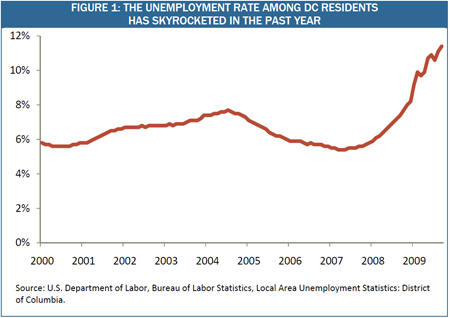The latest unemployment data for DC tell two conflicting stories. Over the past year, DC the city is not losing jobs, while most states across the nation are losing thousands. But DC residents are falling into unemployment at an incredibly historically high rate. It may be yet another sign that the skills of many DC residents are not well matched to the jobs created in the city ‘ and a call for stepped-up workforce training.
DC’s unemployment rate has quickly climbed to 11.4 percent in September. Some 37,500 DC residents are out of work and actively looking for a job but cannot find one. In just one year, the unemployment rate has risen from 7.4 percent to 11.4 percent, a 50 percent increase.
When people say DC is weathering the economic recession better than most places, it is clearly not the case for everyone.
What they may have in mind is the fact that DC as a city is not losing jobs the way other places are. Data from the Bureau of Labor Statistics show employment in DC has been flat over the past year. That’s good news, actually. Nearly every other state has seen big drops.
But the flat employment doesn’t mean some areas have not shed jobs over the year. In fact, DC’s construction industry lost 7,000 jobs in the last year. Trade, transportation and utilities, manufacturing, and professional and business services also had large losses. Only two industries had net gains’ education and health services (200) and the government ‘ including federal and DC (5,400).
What do these numbers tell us? While the District appears to be holding on to its jobs, thousands of DC residents are losing theirs. And even though jobs are being added to the market, it does not seem that they are going to unemployed DC residents. This suggests that the skills of unemployed DC residents may not be matching the skills required by the industries that are adding jobs.
The District could help reverse the skyrocketing trend in unemployment by really focusing on improving its workforce development programs. This could help get DC residents into the jobs that are available now ‘ and those that will become available as the economy recovers.

